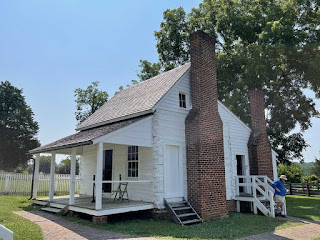Today we drove about two hours west to Appomattox VA to see the Appomattox Court House National Historical Park. This park and surrounding location is significant as it is where, on 9 Apr 1865, Confederate Gen Robert E. Lee surrendered the Army of North Virginia to Union Gen Ulysses S. Grant and started the process of ending the Civil War. I always thought this was the end of the wat but I learned there were actually 13 different surrenders and events that occurred after the signing of the surrender here, one of which was in Liverpool England!
Check this out! Back in the day, many county seats were identified by the name of the county followed by the words "court house". So Appomattox Court House was actually the village name and it so happened to have the Appomattox Court House building here! The final battle here that led to the surrender was the Battle of Appomattox Court House, the village not the building! Many like me thought the surrender document was signed in the court house, but the actual signing occurred in the nearby private residence of Wilmer McLean. These buildings are all here, some re-creations and some original. According to the Park Rangers it was not all that many years ago that the roads leading in and out of this village were driven by automobiles.At the crossroad is the Appomattox Court House building off to the right. It also serves as the present day park visitor center, but unfortunately it has yet to reopen from COVID. They apparently used the COVID closure to start a big remodel and now the contractors are not showing up to finish the job.
We headed west down the road to the McLean House where the surrender document was signed. Out in front of the house is the well.Interesting story about this house. McLean had apparently made a fortune smuggling sugar, but it was all in confederate currency which was worthless at the end of the war. So McLean defaulted on his loan, moved away and the house went up for public auction. It took on the name of the "surrender house" and went through a few owners until it was purchased by some investors. They devised a plan to capitalize on the history of the house, and in 1893 disassemble it and planned to move it to Washington DC. That never occurred and so the house sat in a heap in the front yard. Locals pilfered many of the bricks and lumber, but in 1940 the National Park Service reconstructed it on it's original foundation as it sits today.
In the parlor, Grant and Lee met along with some of their men and the surrender was documented.
The rest of the lower floor is open to view, but the upstairs is closed off to touring.
From here we walked back towards the crossroads and past the general store.
Several of the buildings were not open, such as the tavern kitchen building which serves as the NPS book store now. The slave quarters was turned into a modern bathroom. In front of that was the Clover Hill Tavern. It is the oldest village structure. We were tight on time and there were groups waiting to tour it, so we did not go in.































No comments:
Post a Comment